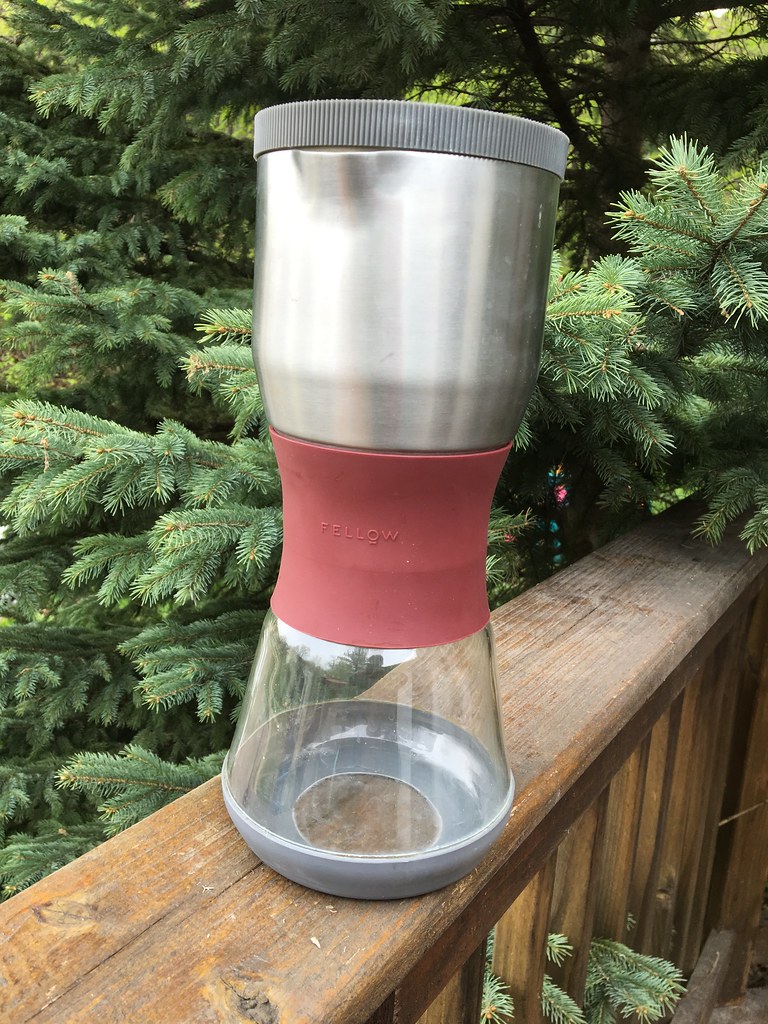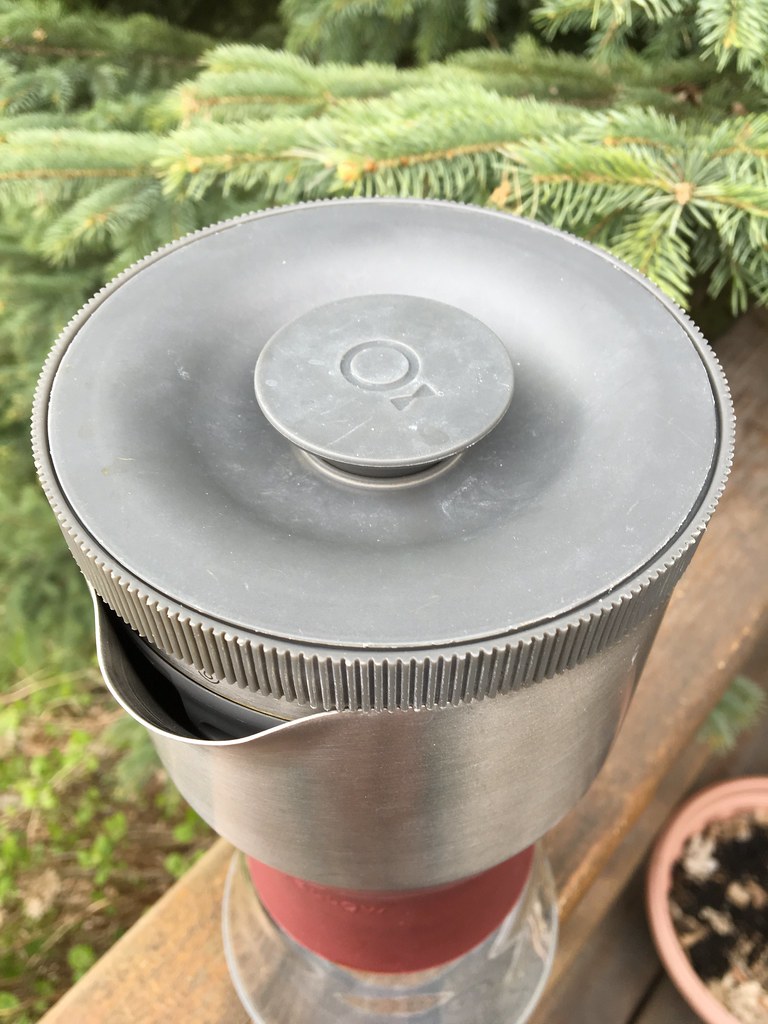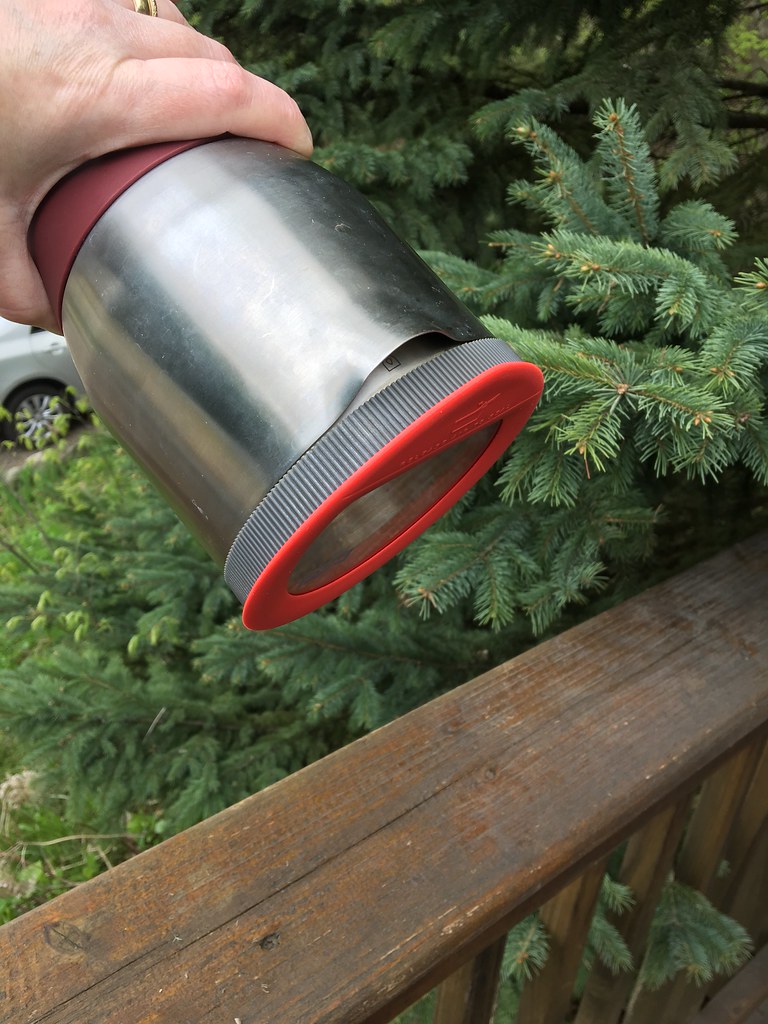So, I've read a LOT about Orphan Espresso's Lido 2. People rave about the grind consistency, the stepless adjustment that makes fine-tuning your grind easy, and the quality of the product.
So, eventually my curiosity overcame my sticker-shock ($175 for the grinder, plus an add-on lid for the hopper, and shipping brought the total to $205), and bought it. My husband and I each get an "allowance" of discretionary spending each month, and this meant I got only a partial allowance for FOUR MONTHS.
Do I like it? Yeah, I really, really do. It's a glass and metal grinder that feels like a precision machine.
And, it's a beast.
It's heavy, weighing 3.5 pounds (about 1.5 kilograms), and at 13" tall, it's about the size of one of those pepper grinders that waiters wield over your salad at places like Olive Garden. And it just feels sturdy and well built.
It's a great size for gripping between your thighs to brace it when sitting, or if you are standing, I use the "swirl" motion they suggest - you brace the bottom of the grinder agains your thigh, and turn the crank to grind, while swirling the body of the grinder in the opposite direction. Despite its size and weight, the ergonomics are the best of all the hand grinders I've used.
One huge plus is that the burrs are much bigger than the ones in my other grinders, and the mechanical advantage is kind of wonderful. I haven't counted the turns, but it takes about 1/2 the time to grind the beans for my daily cup.
So, since I value consistency, I'll do my usual pros and cons:
Pros:
- Most consistent grind I've seen so far in a hand grinder.
- Beautifully designed and sturdy.
- All parts are replaceable should something break.
- Very large burrs cut the grind time in half
- Easy to adjust.
- Cleaning and maintenance tools, and a stand are standard.
- Ergonomics are really good.
Cons:
- Expensive - $175.
- Doesn't come with a lid (but you can buy one separately).
- Heavy and bulky. You can travel with it, but I wouldn't want to.
- Sometimes a bit hard to get the grind started (something that's a problem in nearly all hand grinders, and this one is actually somewhat better than most).
- Steel (not stainless) burrs, so could rust (very very unlikely, if you treat it as the company recommends, plus steel stays sharp longer than stainless does)
To adjust the grind, you loosen/unscrew the locking ring (the narrow silver ring, just above the wider silver ring, just above the glass catch chamber), and twist the wider ring/catch chamber to loosen or tighten the burrs. Then you re-tighten the locking ring. I STILL wish the vertical lines/marks had numbers, but the reason they don't, is that you can actually twist the adjustment ring more than one full revolution.
Not shown in the picture is an add on - a lid for the top of the grinder that was actually designed for their Lido 3 (an all-plastic model with a folding handle for travel, which is about the same size of the Lido 2, but a good pound or so lighter). I HATE it when beans jump out of the hopper, and while the hopper is tall and narrow enough that jumping bean bits are rare, it was still worth it to me to spend the few extra dollars to get the lid.
The grinder does produce static, not something I've had to deal with before (the burrs are steel, rather than ceramic, so that might be the difference). I simply put the water in the microwave to heat, grind the beans, then let the grinder sit until the water is ready. The static dissipates during those few minutes. Some folks sprinkle a drop or two of water on top of the beans in the hopper just before grinding (and those who do it says it works great), but that seems like a bad idea to me. These are steel (not stainless) burrs and could rust, and even though they get conditioned by the coffee oils from the beans, I don't want to introduce more moisture if I can avoid it. I also backed a coffee sieve on Kickstarter, and I suspect that the water droplets could well interfere with that process, causing the fines to stick to stuff. So, I use OE's suggestion to let the grounds sit for a few minutes until the static dissipates on its own.
Does the grinder produce a better cup of coffee? Yes, it does.
I can't rule out confirmation bias, though - I mean, I want it to produce better coffee, given that I spent so much money on it. ALL grinders produce some inconsistencies: boulders - overly big chunks that manage to fit through the burrs without getting chewed up, that impart sour flavors, and fines, the powdery particles that over-extract, producing bitter flavors), and the Lido 2 is no exception. But, it does produce the most consistent grind by far, and I think I detected a legitimate improvement in my cup of coffee.
Finally, a note about Orphan Espresso. They are a small-business, and started out by restoring vintage coffee grinders, and got so intimately familiar with what makes a good grinder, that they started designing their own. Their grinders are so good, that they were featured on NPR: The Search For The Perfect Cup Of Coffee Can Be Such A Grind(er)










